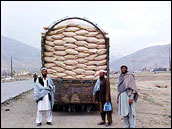

Sounding the Warning: FEWS NET | |||
The springtime floods provide a good example of how FEWS NET works. The vegetation index maps, weather information, and water availability are digested into flood or drought warnings, which are folded into a FEWS NET bulletin and distributed to the Afghan government and aid agencies. “We identify food security issues in the bulletin,” says Rahimi, outlining the primary purpose of the bi-monthly report. The bulletin is sent to the president and cabinet members for discussion in cabinet meetings, as well as officials in each of the 33 ministries in the Afghan government and up to 400 individuals in donor agencies and international organizations. Between reports, FEWS NET sends out a weekly climate forecast, which predicts weather conditions for the next seven days. Distributed to the same people who get the food-security bulletin, the climate forecast can warn of possible weather-related disasters like severe storms, floods, or extreme temperatures. Another example of FEWS NET in action occurred when drought threatened food supplies in 2004. “Last year [2004], FEWS NET forecast a serious shortage of water. The Cabinet formed a commission to respond,” reports Rahimi. The commission visited those provinces that FEWS NET warned were at high risk. “In these two assessments [FEWS NET’s satellite assessment and the government’s ground assessment], they found that 26 provinces were in trouble. They sent an appeal to the international food aid community.” Because the appeal went out before a serious famine developed, aid organizations had extra time to gather the resources needed to prevent disaster. The FEWS NET reports are helpful because, as Andrew Pinney explains, the number of people who need food aid in Afghanistan is highly variable. Pinney is an advisor to the Vulnerability Analysis Unit of the Ministry of Rural Rehabilitation and Development in the Afghan government. With as much as 85 percent of the population economically dependent on agriculture, swings in the weather can lead to a rapid change in fortune. The possibility for rapid swings in the weather and food security underscores the value of including satellite observations in the FEWS NET reports. Satellites regularly provide a view of crop and water conditions in the entire country at a single glance—something that would be impossible to do otherwise. Afghanistan’s decision makers are anxious to get the FEWS NET reports as they try to assess the needs of the people, says Rahimi. |


USAID provided 7,000 metric tons of wheat seed to Afghanistan in the spring of 2002. (Photos courtesy USAID) | ||